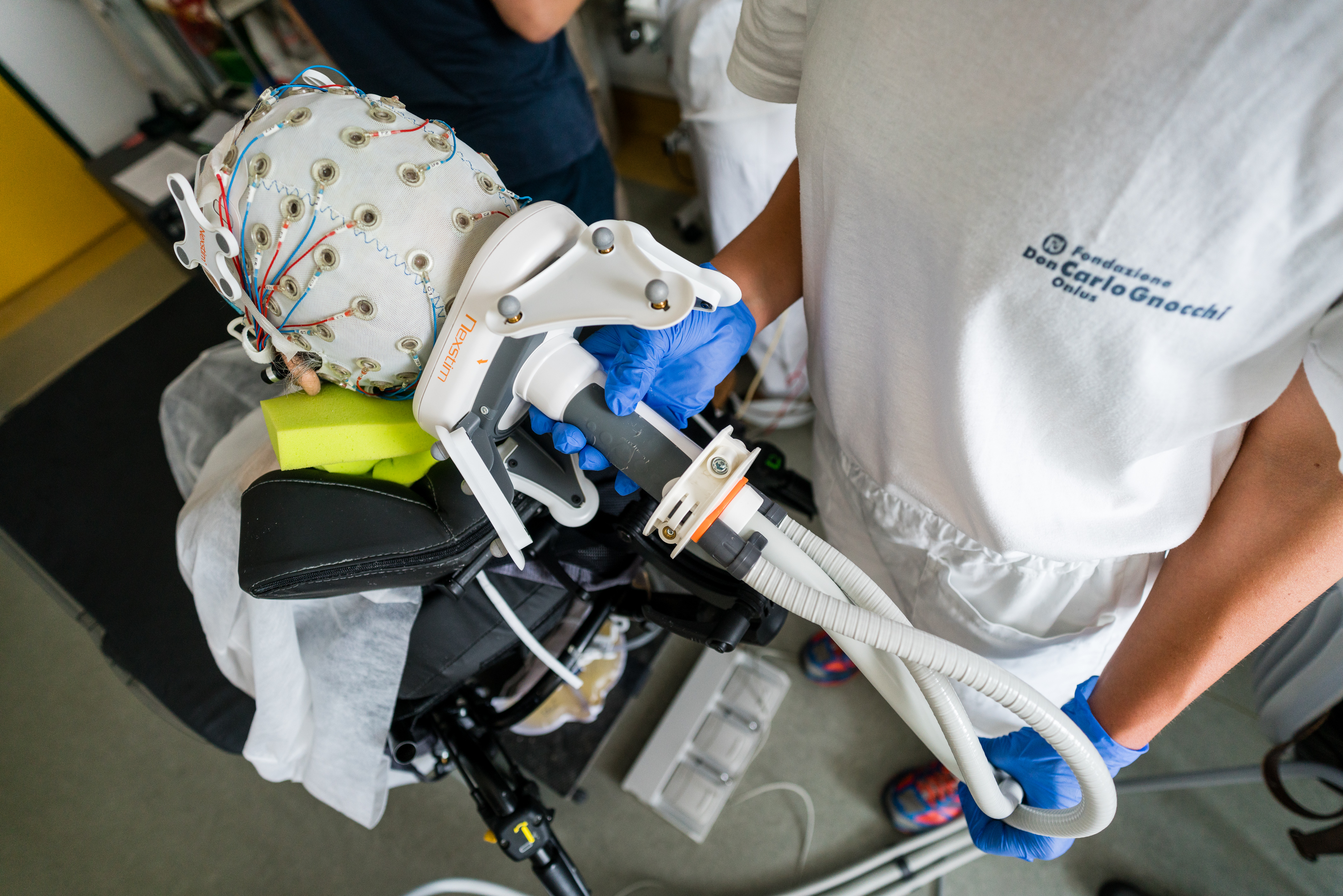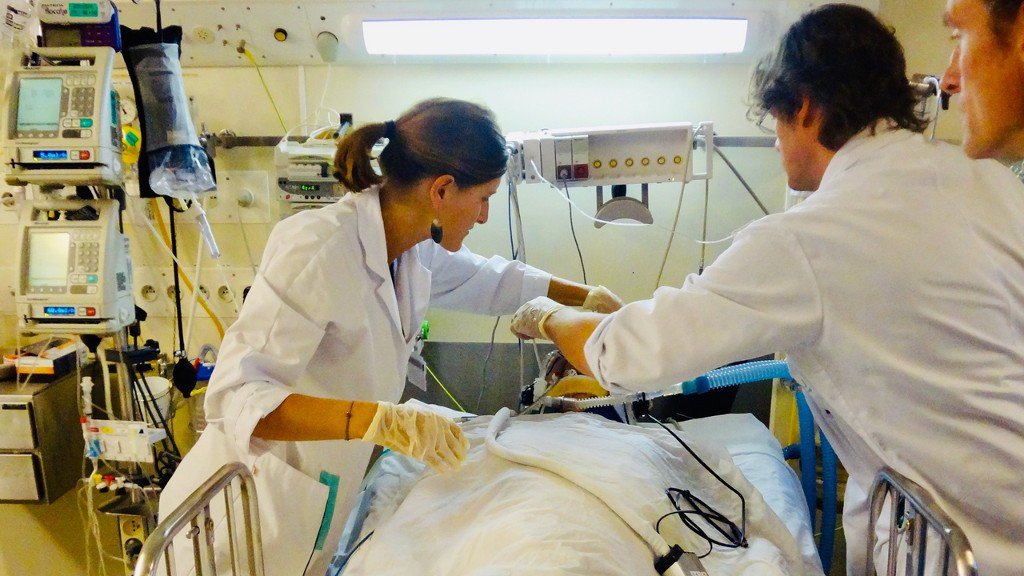- Feature
Measuring consciousness – from the lab to the clinic
30 August 2023
Where in the brain does consciousness emerge? Is it possible to detect the faintest signs of consciousness after it has been lost? Is there a way to restore consciousness, “bringing back” a patient after severe brain injury? Scientists in the HBP have been attempting to unravel these and other mysteries of consciousness and have made significant progress: they have developed new methods to better distinguish different states of consciousness on the brain level – from awake to asleep, to anaesthetised, to impaired due to brain injury or disease – and have made advances towards potential new treatments and better care for people who have lost consciousness.
What it means precisely to be conscious is debated among philosophers and scientists, with most definitions centering on the ability to have subjective experiences – an inner sensation of what it is like to see an image, hear a sound, think a thought or feel an emotion. For clinicians working on disorders of consciousness, such questions have to be decided on an even more practical level. Here, diagnosing the conscious states of a patient has to be tied to observables – signs of alertness and responsiveness are the first on the checklist. But what if a patient is unable to respond in any way, yet still retains a level of awareness, feelings or even acute pain in need of treatment?
The search for signs of consciousness
Every year, thousands of such patients are sent to emergency services worldwide after severe brain injuries. A correct assessment of the level of consciousness is key for an adequate diagnosis, treatment decision and rehabilitation.
A multinational team of HBP scientists is working on new methods to detect states of consciousness directly at the brain level. With sophisticated experiments, modelling and theory, they are hunting for reliable signs that indicate if a patient is even just minimally conscious and potentially able to recover – in other words, if the patient is “still there”.
HBP scientists at the University of Milan have developed a novel non-invasive approach to measure the level of consciousness, called the Perturbational Complexity Index (PCI). For this, a weak magnetic pulse is applied to the head of a patient, momentarily perturbing the electrical brain activity that is always present in the living brain – in the awake and asleep states, during anaesthesia and even during deep coma. The brain response to this pulse is simultaneously measured. The method, which has been tested and verified in collaboration with HBP colleagues at the University Hospital of Liège, reveals that it is not the strength of the response which is indicative of the level of consciousness of a person, but rather its complexity, which can be calculated as a single number (Comolatti et al. 2019, Lutkenhoff et al. 2020). The PCI could therefore become a powerful clinical advance for disorders of consciousness.

In order to better understand underlying patterns of the brain’s response to external stimuli and their relation to brain states at the whole-brain level, the clinical scientists collaborated with theoretical neuroscientists at CNRS in Paris to model and simulate these brain states in the computer. These multi-scale computational models of brain networks associated with different states of consciousness enable the understanding of PCI data, and they allow integration of data across different scales – from the level of neurons up to the whole brain.
What is the mechanism behind the loss of complexity measured by the PCI? Clinical studies in the HBP previously showed that the loss of brain complexity during disorders of consciousness is due to a pathological tendency of cortical circuits to fall into silence (or into so-called “OFF-periods”) upon receiving an input (Rosanovat al. 2018). In 2022, HBP researchers studied this process in animal models and provided a deeper, dynamic understanding of these OFF-periods, opening doors to potential therapeutic interventions (Camassa et al. 2022).
Distinguishing states of consciousness
Several recent studies coming out of these HBP collaborations have greatly contributed to addressing the challenge of correctly diagnosing levels of consciousness, working towards better clinical care for patients suffering from severe brain damage.
One example is the recent work of HBP researchers from the University of Liège, the Pompeu Fabra University in Barcelona, the Vrije Universiteit Amsterdam, and collaborators, who have developed new techniques that may eventually allow researchers and clinicians to distinguish two specific neurological conditions: the unresponsive wakefulness syndrome and the minimally conscious state (Panda et al. 2022).

Previously known as the “vegetative state”, unresponsive wakefulness syndrome is the condition of a patient who wakes from coma (that is, opens the eyes) but remains unresponsive to the environment and verbal commands, showing only reflex movements. By contrast, patients in a minimally conscious state tend to show small signs of awareness such as tracking movements with their eyes or moving a finger when asked.
The researchers used functional magnetic resonance imaging (fMRI) data to assess different aspects of brain structure and network dynamics and demonstrated that these brain-based techniques for functional connectivity measurement are sensitive enough to detect relevant differences for better differentiating these two states in diagnosis.
Inspiration from physics
In search of better theoretical approaches to measuring and modelling levels of consciousness, the HBP team at Pompeu Fabra University, in collaboration with researchers from the University of Buenos Aires and the University of Oxford, has also taken inspiration from physics – namely, the second law of thermodynamics.
For many years inside the HBP, this group had been studying how the dynamics of the brain change in different states. Now, based on a key idea of thermodynamics – that production entropy always increases when an irreversible process occurs in a system – the researchers have developed a new framework for finding precise signatures of three brain states: awake, deep asleep and anaesthetised. The researchers analysed the relationships of different parts of the brain with a large human fMRI dataset and found that, in unconscious states, the measured “non-reversibility” of brain activity decreases (Deco et al. 2022). This turns out to be a very good biomarker for classifying the different brain states.
Help from artificial intelligence
State-of-the-art artificial intelligence tools are also being employed to help clinicians reduce the diagnostic uncertainty for coma survivors. In a recent study, researchers from Korea University collaborated with HBP teams from the University of Liège and the University of Milan, as well as with researchers from the University of Wisconsin to develop novel and unique markers of levels of consciousness using deep-learning technologies (Lee et al. 2022).
The teams analysed electrical measurements of brain function in more than one hundred participants under different conditions of altered consciousness – including sleep, anaesthesia and severe brain injury. They used deep learning to disentangle the components of consciousness from the data.
In addition to tackling the challenge of measuring states of consciousness for diagnostic purposes, HBP researchers are also working on novel therapeutic approaches to help unconscious patients. HBP researchers from the University of Paris-Saclay and CEA Neurospin have recently made another advance in the search for the next potential treatment. They found evidence that deep brain stimulation (DBS) may have the potential to restore wakefulness and awareness in patients with disorders of consciousness (Tasserie et al. 2022).
Brain imaging studies had already suggested that restoring communication between the cortex and the thalamus might be key to recovering consciousness. The HBP team has now demonstrated that the thalamus centre is the right target for stimulation in order to restore levels of consciousness.
Consciousness, a phenomenon both central to every moment of our being and one of the hardest clinical challenges when disturbed, had long been considered too complex to address and thus outside of the realm of science. With neuroscientists, clinicians and computational theorists breaking new ground, this picture is beginning to change.
This text was first published in the booklet ‘Human Brain Project – A closer look at scientific advances’, which includes feature articles, interviews with leading researchers and spotlights on latest research and innovation. Read the full booklet here.
References
Camassa A, Galluzzi A, Mattia M, Sanchez-Vives MV (2022). Deterministic and Stochastic Components of Cortical Down States: Dynamics and Modulation. J. Neurosci. 42(50):9387-9400. doi: 10.1523/JNEUROSCI.0914-22.2022
Comolatti R, Pigorini A, Casarotto S, Fecchio M, Faria G, Sarasso S, Rosanova M, Gosseries O, Boly M, Bodart O, Ledoux D, Brichant JF, Nobili L, Laureys S, Tononi G, Massimini M, Casali AG (2019). A fast and general method to empirically estimate the complexity of brain responses to transcranial and intracranial stimulations. Brain stimul. 12(5):1280-9. doi: 10.1016/j.brs.2019.05.013
Deco G, Sanz Perl Y, Bocaccio H, Tagliazucchi E, Kringelbach ML (2022). The INSIDEOUT framework provides precise signatures of the balance of intrinsic and extrinsic dynamics in brain states. Commun. Biol. 5(1):572. doi: 10.1038/s42003-022-03505-7
Lee M, Sanz LRD, Barra A, Wolff A, Nieminen JO, Boly M, Rosanova M, Casarotto S, Bodart O, Annen J, Thibaut A, Panda R, Bonhomme V, Massimini M, Tononi G, Laureys S, Gosseries O, Lee SW (2022). Quantifying arousal and awareness in altered states of consciousness using interpretable deep learning. Nat. Commun. 13(1):1064. doi: 10.1038/s41467-022-28451-0



